Determination of the Most Optimal On-Shore Wind Farm Site Location Using a GIS-MCDM Methodology: Evaluating the Case of South Korea
Abstract
:1. Introduction
2. Materials and Methods
2.1. Analytical Hierarchy Process (AHP)
2.2. Fuzzy Triangular Numbers (FTNs)
2.3. Fuzzy-Analytical Hierarchy Process (FAHP)
- Step 3a: For each criterion, calculate the vector summation of the fuzzy geometric mean as calculated in Step 2.
- Step 3b: Take the inverse of summation vector and arrange the fuzzy triangular numbers in an increasing order.
- Step 3c: In order to estimate the fuzzy weight of the i-th criterion , multiply the reverse vector with its .
2.4. MCDM Problem: Locating the Most Optimal On-Shore Wind Farm Sites in South Korea
2.4.1. Restricted and Protected Areas
2.4.2. Site Evaluating Criterion
3. Results and Discussion
3.1. Multiple Scenarios
3.2. Wind Farm Suitability Maps
3.3. Identification of Top Wind Farm Sites
4. Conclusions
Acknowledgments
Author Contributions
Conflicts of Interest
Nomenclature
| i | i-th value of a parameter |
| Fuzzy triangular membership function | |
| w | Non-fuzzy normalized weightage assigned to each criteria |
| l | Lower limit of criteria weightage |
| m | Mean value of criteria weightage |
| u | Upper limit of criteria weightage |
| n | Number of criteria |
| C | Criteria |
| E | Expert |
| R | Restricted areas |
| Fuzzy matrix | |
| Cij | Relative score of i-th criteria w.r.t. j-th criteria |
| Ci,j | Average value of i-th criteria for j-th site |
| Geometric mean of fuzzy numbers assigned to a criteria | |
| A | Non-normalized non-fuzzy weight of a criteria (de-fuzzification) |
| Ci,min | The minimum value of i-th criteria across all sites |
| Ci,max | The maximum value of i-th criteria across all sites |
References
- Van Haaren, R.; Fthenakis, V. GIS-based wind farm site selection using spatial multi-criteria analysis (SMCA): Evaluating the case for New York State. Renew. Sustain. Energy Rev. 2011, 15, 3332–3340. [Google Scholar] [CrossRef]
- Latinopoulos, D.; Kechagia, K. A GIS-based multi-criteria evaluation for wind farm site selection. A regional scale application in Greece. Renew. Energy 2015, 78, 550–560. [Google Scholar] [CrossRef]
- Noorollahi, Y.; Yousefi, H.; Mohammadi, M. Multi-criteria decision support system for wind farm site selection using GIS. Sustain. Energy Technol. Assess. 2016, 13, 38–50. [Google Scholar]
- Janke, J.R. Multi-criteria GIS modeling of wind and solar farms in Colorado. Renew. Energy 2010, 35, 2228–2234. [Google Scholar] [CrossRef]
- Rodman, L.C.; Meentemeyer, R.K. A geographic analysis of wind turbine placement in Northern California. Energy Policy 2006, 34, 2137–2149. [Google Scholar] [CrossRef]
- Grassi, S.; Chokani, N.; Abhari, R.S. Large scale technical and economical assessment of wind energy potential with a GIS tool: Case study Iowa. Energy Policy 2012, 45, 73–85. [Google Scholar] [CrossRef]
- Yue, C.-D.; Wang, S.-S. GIS-based evaluation of multifarious local renewable energy sources: A case study of the Chigu area of southwestern Taiwan. Energy Policy 2006, 34, 730–742. [Google Scholar] [CrossRef]
- Baban, S.M.; Parry, T. Developing and applying a GIS-assisted approach to locating wind farms in the UK. Renew. Energy 2001, 24, 59–71. [Google Scholar] [CrossRef]
- Park, U.-S.; Yoo, N.-S.; Kim, J.-H.; Kim, K.-S.; Min, D.-H.; Lee, S.-W.; Kim, H.-G. The Selection of Promising Wind Farm Sites in Gangwon Province using Multi Exclusion Analysis. J. Korean Solar Energy Soc. 2015, 35, 1–10. [Google Scholar] [CrossRef]
- Kim, H.-G. Preliminary estimation of wind resource potential in South Korea. J. Korean Solar Energy Soc. 2008, 28, 1–7. [Google Scholar]
- Jang, J.-K.; Yu, B.-M.; Ryu, K.-W.; Lee, J.-S. Offshore wind resource assessment around Korean Peninsula by using QuikSCAT satellite data. J. Korean Soc. Aeronaut. Space Sci. 2009, 37, 1121–1130. [Google Scholar] [CrossRef]
- Oh, K.-Y.; Kim, J.-Y.; Lee, J.-K.; Ryu, M.-S.; Lee, J.-S. An assessment of wind energy potential at the demonstration offshore wind farm in Korea. Energy 2012, 46, 555–563. [Google Scholar] [CrossRef]
- Kim, H.; Kim, B. Wind resource assessment and comparative economic analysis using AMOS data on a 30 MW wind farm at Yulchon district in Korea. Renew. Energy 2016, 85, 96–103. [Google Scholar] [CrossRef]
- Lee, M.E.; Kim, G.; Jeong, S.-T.; Ko, D.H.; Kang, K.S. Assessment of offshore wind energy at Younggwang in Korea. Renew. Sustain. Energy Rev. 2013, 21, 131–141. [Google Scholar] [CrossRef]
- Kim, J.-Y.; Oh, K.-Y.; Kang, K.-S.; Lee, J.-S. Site selection of offshore wind farms around the Korean Peninsula through economic evaluation. Renew. Energy 2013, 54, 189–195. [Google Scholar] [CrossRef]
- Oh, K.-Y.; Kim, J.-Y.; Lee, J.-S.; Ryu, K.-W. Wind resource assessment around Korean Peninsula for feasibility study on 100 MW class offshore wind farm. Renew. Energy 2012, 42, 217–226. [Google Scholar] [CrossRef]
- Saaty, T.L. The Analytic Hierarchy Process; McGraw Hill International: New York City, NY, USA, 1980. [Google Scholar]
- Zadeh, L.A. “Fuzzy Sets”. Inf. Control 1965, 8, 199–249. [Google Scholar] [CrossRef]
- Ruoning, X.; Xiaoyan, Z. Extensions of the analytic hierarchy process in fuzzy environment. Fuzzy Sets Syst. 1992, 52, 251–257. [Google Scholar] [CrossRef]
- Cheng, C.-H.; Yang, K.-L.; Hwang, C.-L. Evaluating attack helicopters by AHP based on linguistic variable weight. Eur. J. Oper. Res. 1999, 116, 423–435. [Google Scholar] [CrossRef]
- Cheng, C.-H. Evaluating naval tactical missile systems by fuzzy AHP based on the grade value of membership function. Eur. J. Oper. Res. 1997, 96, 343–350. [Google Scholar] [CrossRef]
- Petkovic, J.; Sevarac, Z.; Jaksic, M.L.; Marinkovic, S. Application of fuzzy AHP method for choosing a technology within Service Company. Tech. Technol. Educ. Manag. TTEM 2012, 7, 332–341. [Google Scholar]
- Bellman, R.E.; Zadeh, L.A. Decision-making in a fuzzy environment. Manag. Sci. 1970, 17, B-141–B-164. [Google Scholar] [CrossRef]
- Garcia-Cascales, M.S.; Lamata, M.T. Multi-criteria analysis for a maintenance management problem in an engine factory: Rational choice. J. Intell. Manuf. 2011, 22, 779–788. [Google Scholar] [CrossRef]
- Klir, G.; Yuan, B. Fuzzy Sets and Fuzzy Logic: Theory and Applications; Prentice Hall: Upper Saddle River, NJ, USA, 1995; Volume 4. [Google Scholar]
- Kilincci, O.; Onal, S.A. Fuzzy AHP approach for supplier selection in a washing machine company. Expert Syst. Appl. 2011, 38, 9656–9664. [Google Scholar] [CrossRef]
- Van Laarhoven, P.; Pedrycz, W. A fuzzy extension of Saaty’s priority theory. Fuzzy Sets Syst. 1983, 11, 229–241. [Google Scholar] [CrossRef]
- Chang, D.-Y. Applications of the extent analysis method on fuzzy AHP. Eur. J. Oper. Res. 1996, 95, 649–655. [Google Scholar] [CrossRef]
- Jaber, J.; Jaber, Q.; Sawalha, S.; Mohsen, M. Evaluation of conventional and renewable energy sources for space heating in the household sector. Renew. Sustain. Energy Rev. 2008, 12, 278–289. [Google Scholar] [CrossRef]
- Kahraman, C.; Kaya, İ.; Cebi, S. A comparative analysis for multi attribute selection among renewable energy alternatives using fuzzy axiomatic design and fuzzy analytic hierarchy process. Energy 2009, 34, 1603–1616. [Google Scholar] [CrossRef]
- Heo, E.; Kim, J.; Boo, K.-J. Analysis of the assessment factors for renewable energy dissemination program evaluation using fuzzy AHP. Renew. Sustain. Energy Rev. 2010, 14, 2214–2220. [Google Scholar] [CrossRef]
- Tasri, A.; Susilawati, A. Selection among renewable energy alternatives based on a fuzzy analytic hierarchy process in Indonesia. Sustain. Energy Technol. Assess. 2014, 7, 34–44. [Google Scholar] [CrossRef]
- Ren, J.; Sovacool, B.K. Enhancing China’s energy security: Determining influential factors and effective strategic measures. Energy Convers. Manag. 2014, 88, 589–597. [Google Scholar] [CrossRef]
- Chang, N.-B.; Chang, Y.-H.; Chen, H.-W. Fair fund distribution for a municipal incinerator using GIS-based fuzzy analytic hierarchy process. J. Environ. Manag. 2009, 90, 441–454. [Google Scholar] [CrossRef] [PubMed]
- Chen, H.H.; Kang, H.-Y.; Lee, A.H. Strategic selection of suitable projects for hybrid solar-wind power generation systems. Renew. Sustain. Energy Rev. 2010, 14, 413–421. [Google Scholar] [CrossRef]
- Lee, A.H.; Chen, H.H.; Kang, H.-Y. A model to analyze strategic products for photovoltaic silicon thin-film solar cell power industry. Renew. Sustain. Energy Rev. 2011, 15, 1271–1283. [Google Scholar] [CrossRef]
- Yeh, T.-M.; Huang, Y.-L. Factors in determining wind farm location: Integrating GQM, fuzzy DEMATEL, and ANP. Renew. Energy 2014, 66, 159–169. [Google Scholar] [CrossRef]
- Shafiee, M. A fuzzy analytic network process model to mitigate the risks associated with offshore wind farms. Expert Syst. Appl. 2015, 42, 2143–2152. [Google Scholar] [CrossRef]
- Liu, S.; Zhang, J.; Liu, W.; Qian, Y. A comprehensive decision-making method for wind power integration projects based on improved fuzzy AHP. Energy Procedia 2012, 14, 937–942. [Google Scholar] [CrossRef]
- Lee, A.H.; Hung, M.-C.; Kang, H.-Y.; Pearn, W. A wind turbine evaluation model under a multi-criteria decision making environment. Energy Convers. Manag. 2012, 64, 289–300. [Google Scholar] [CrossRef]
- Buckley, J.J. Fuzzy hierarchical analysis. Fuzzy Sets Syst. 1985, 17, 233–247. [Google Scholar] [CrossRef]
- Chou, S.-W.; Chang, Y.-C. The implementation factors that influence the ERP (enterprise resource planning) benefits. Decis. Support Syst. 2008, 46, 149–157. [Google Scholar] [CrossRef]
- Stat Silk. Available online: https://www.statsilk.com (accessed on 20 September 2017).
- Geofabrik Downloads. Available online: http://download.geofabrik.de/asia/south-korea.html (accessed on 20 September 2017).
- Osm2Shp. Available online: http://osm2shp.ru/ (accessed on 20 September 2017).
- Global Administrative Areas. Available online: http://www.gadm.org/country (accessed on 20 September 2017).
- DIVA-GIS. Available online: http://www.diva-gis.org/gdata (accessed on 20 September 2017).
- Open Street Map Data, Ruduced Waterbodies as Polygons. Available online: http://openstreetmapdata.com/data/water-reduced-polygons (accessed on 20 September 2017).
- MapCruzin. Available online: http://www.mapcruzin.com (accessed on 20 September 2017).
- USGS Science for a Changing World. Available online: https://landcover.usgs.gov/globallandcover.php# (accessed on 20 September 2017).
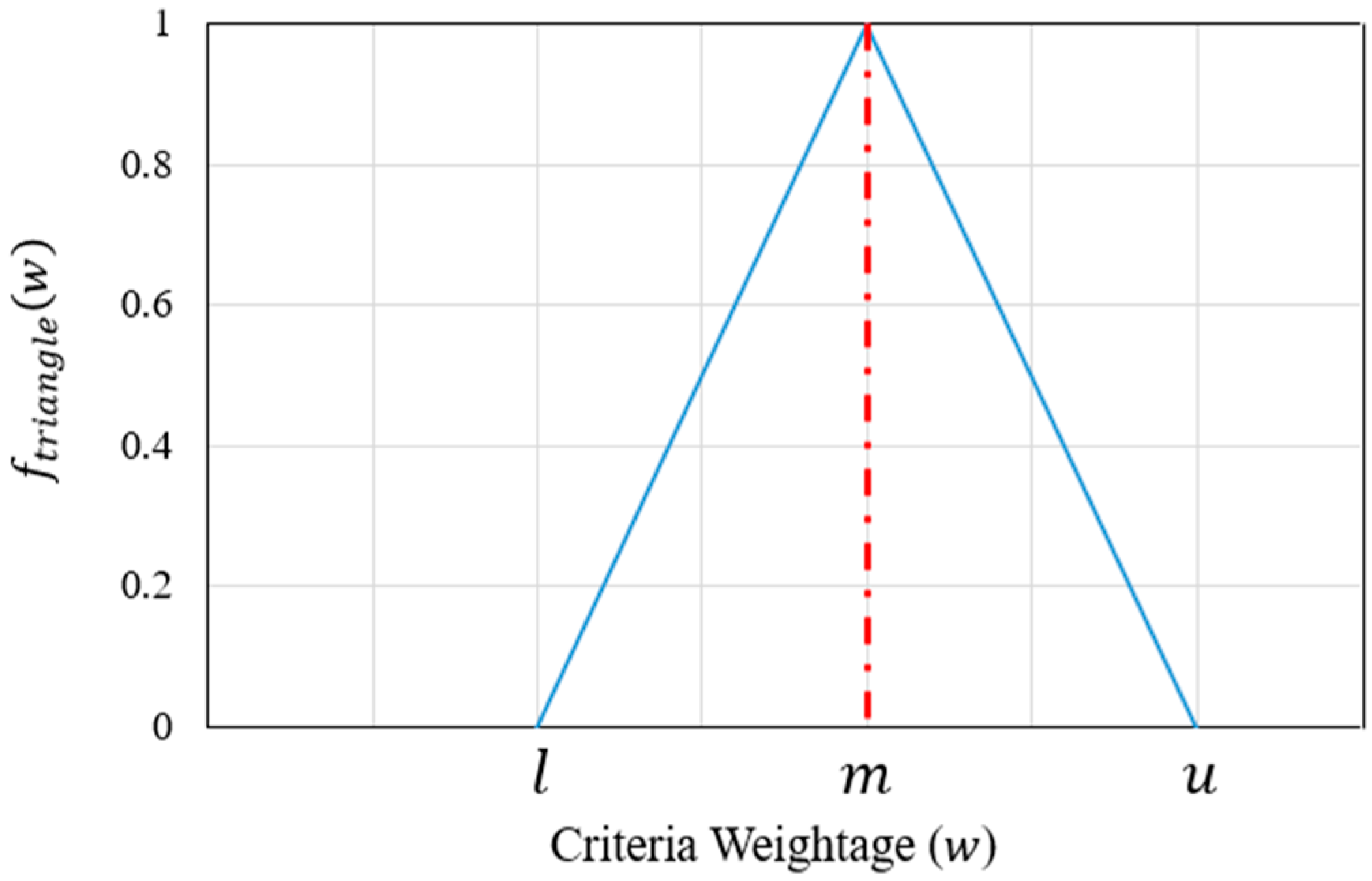
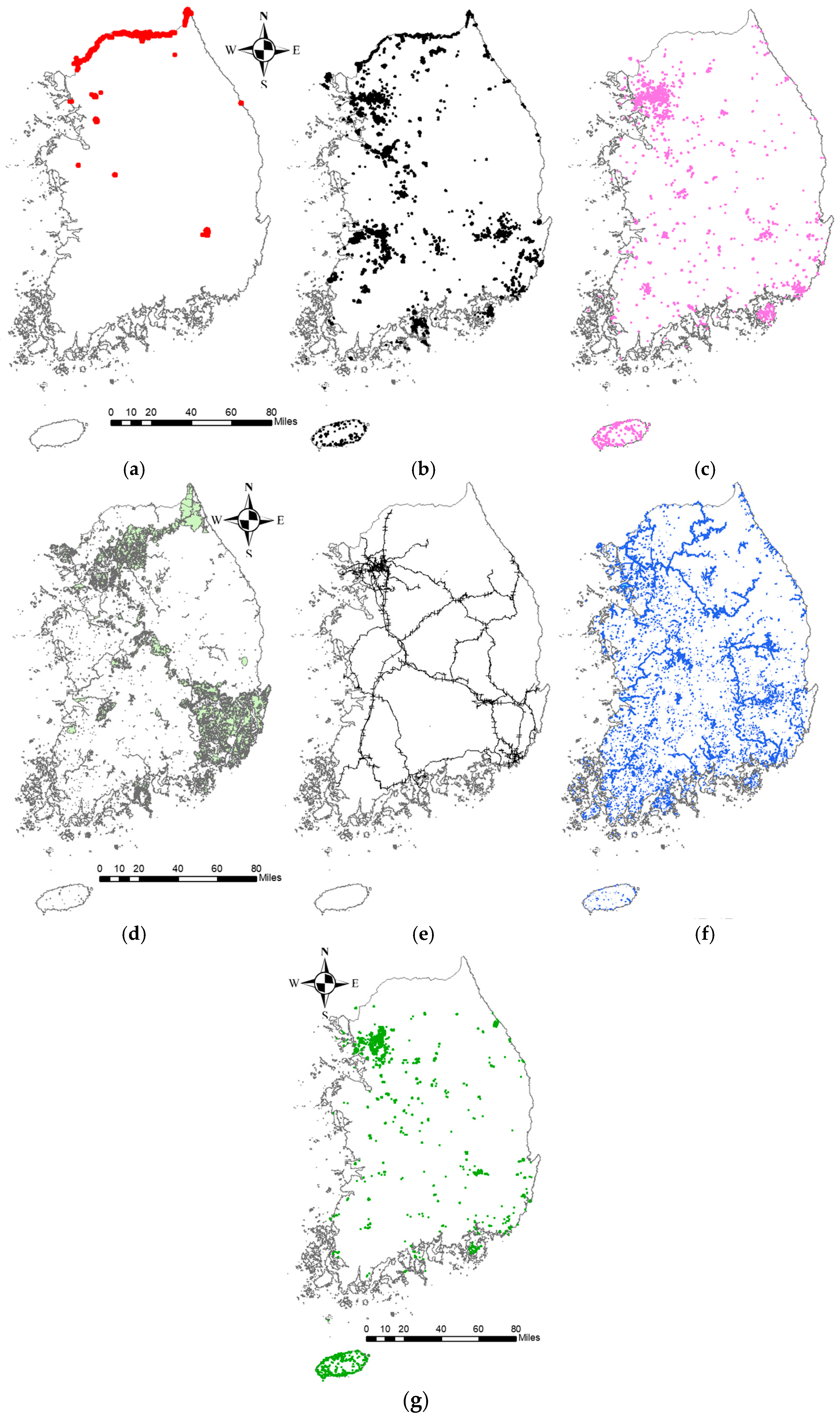
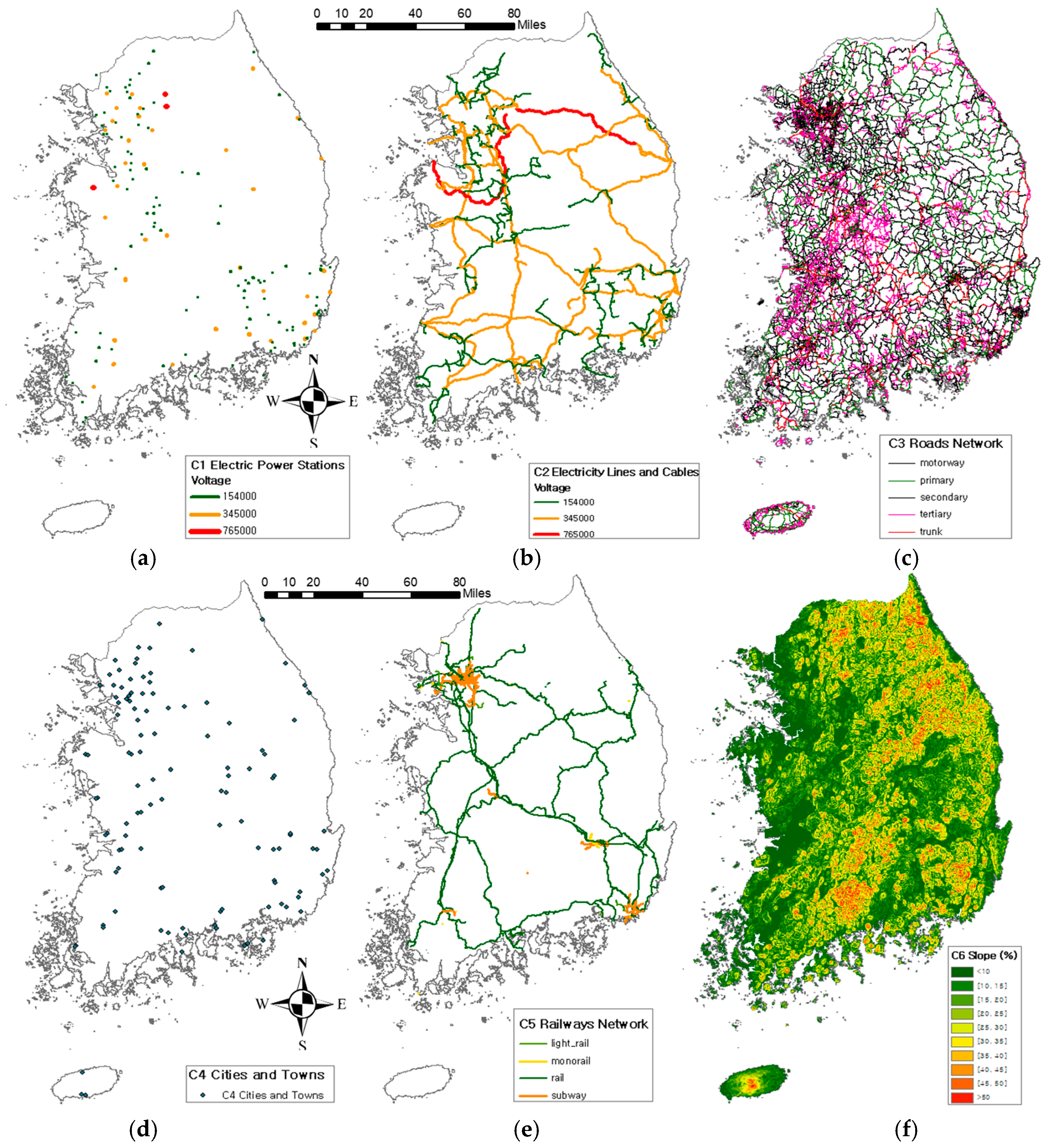
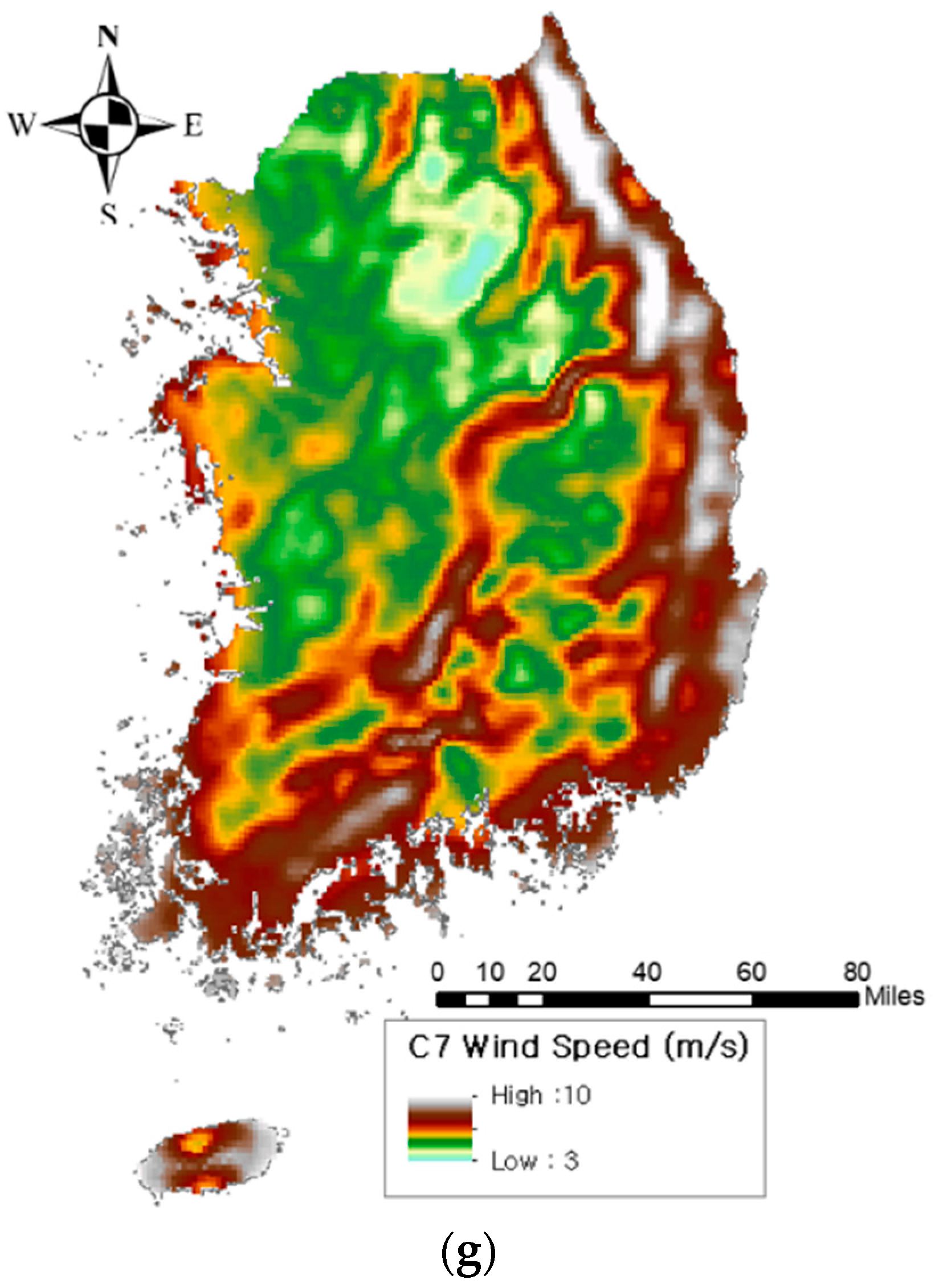
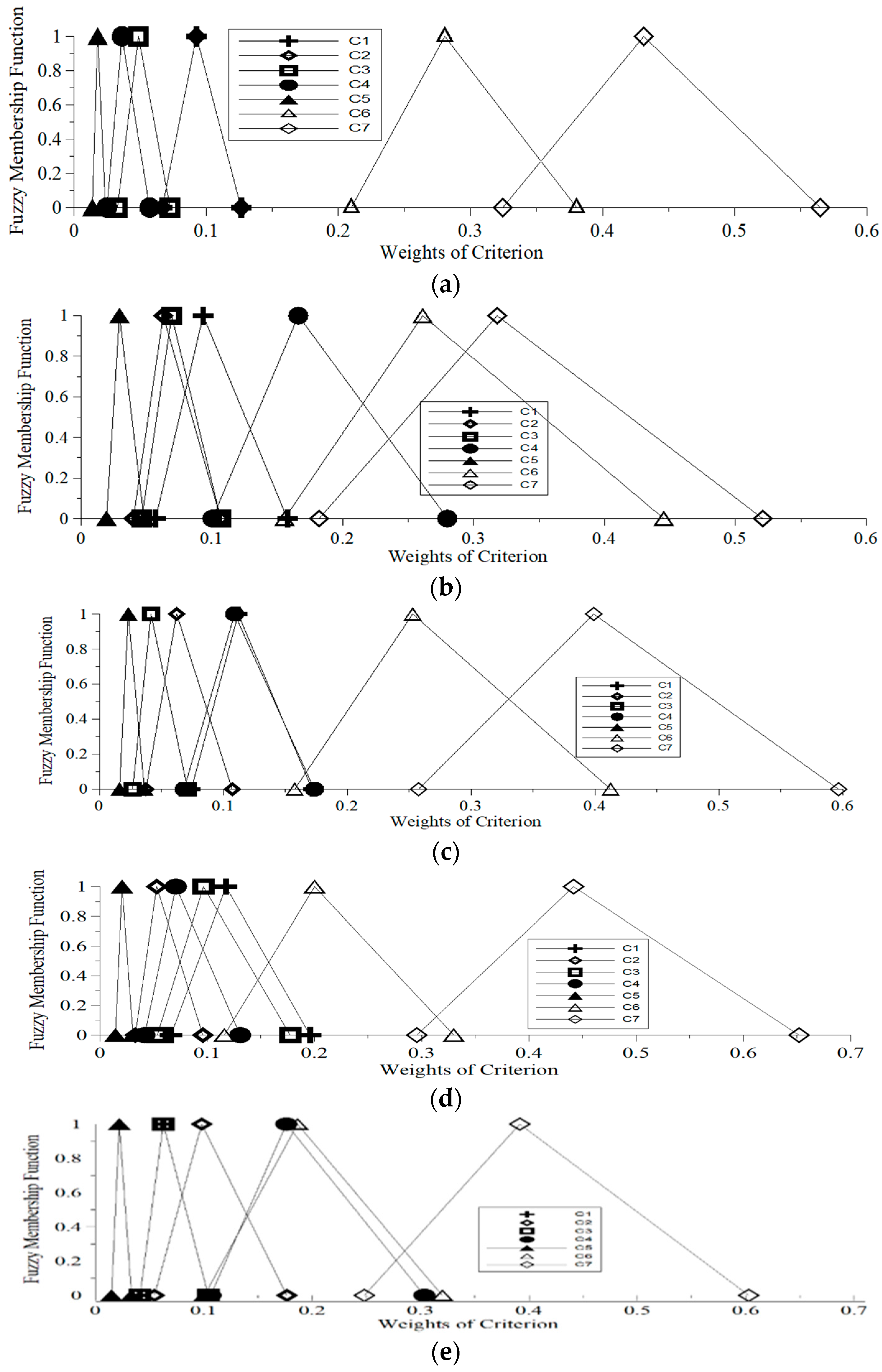
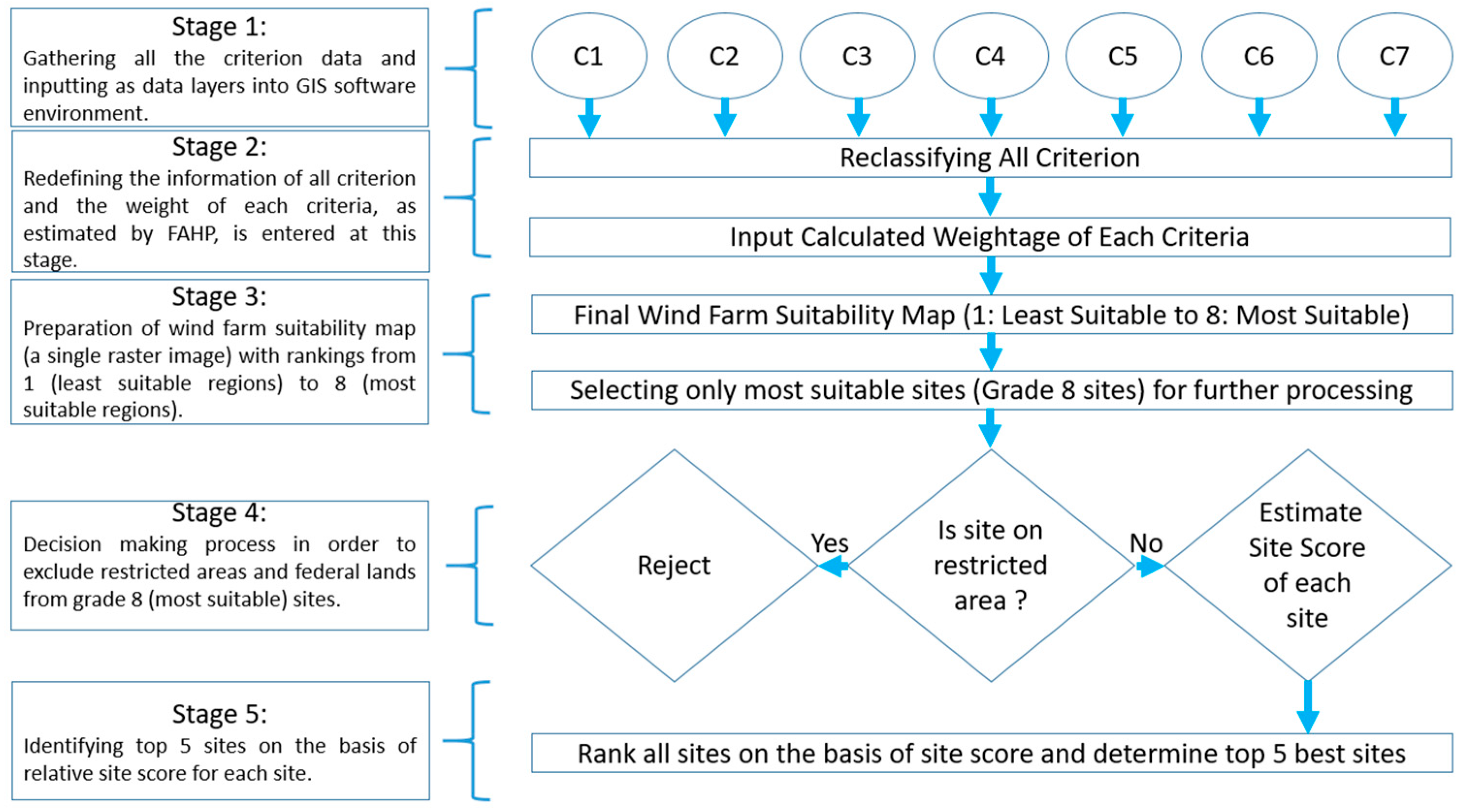
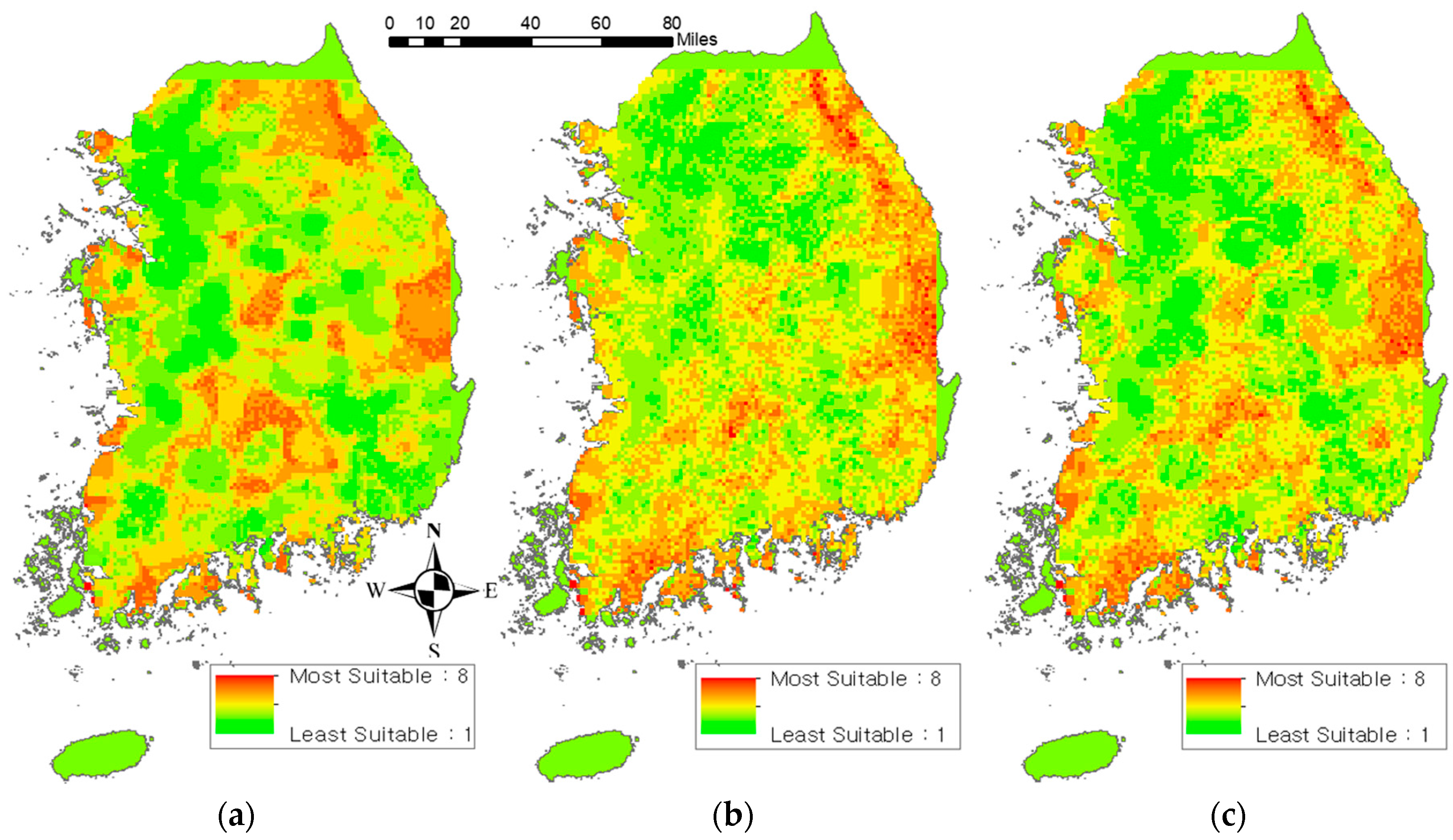
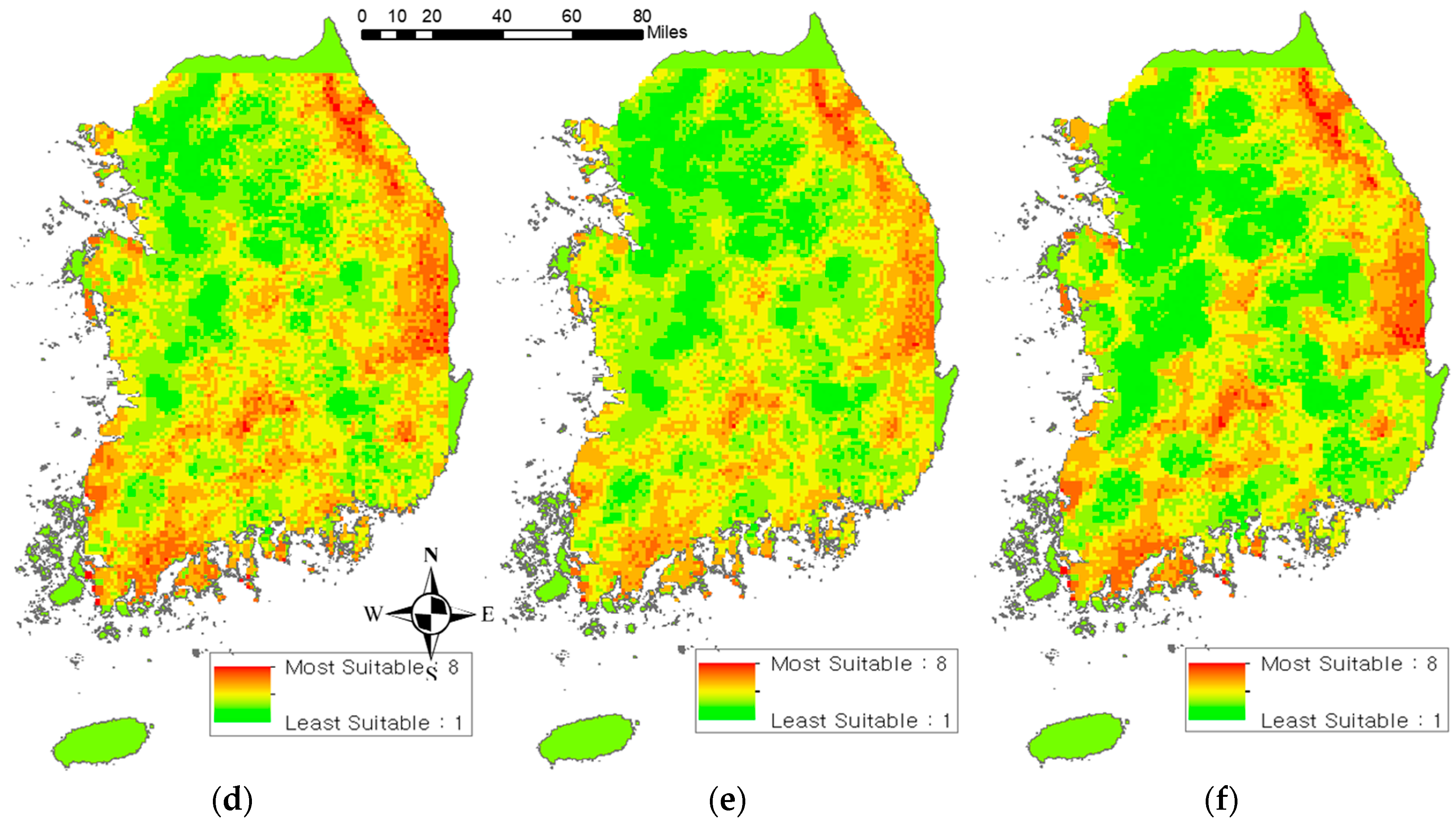
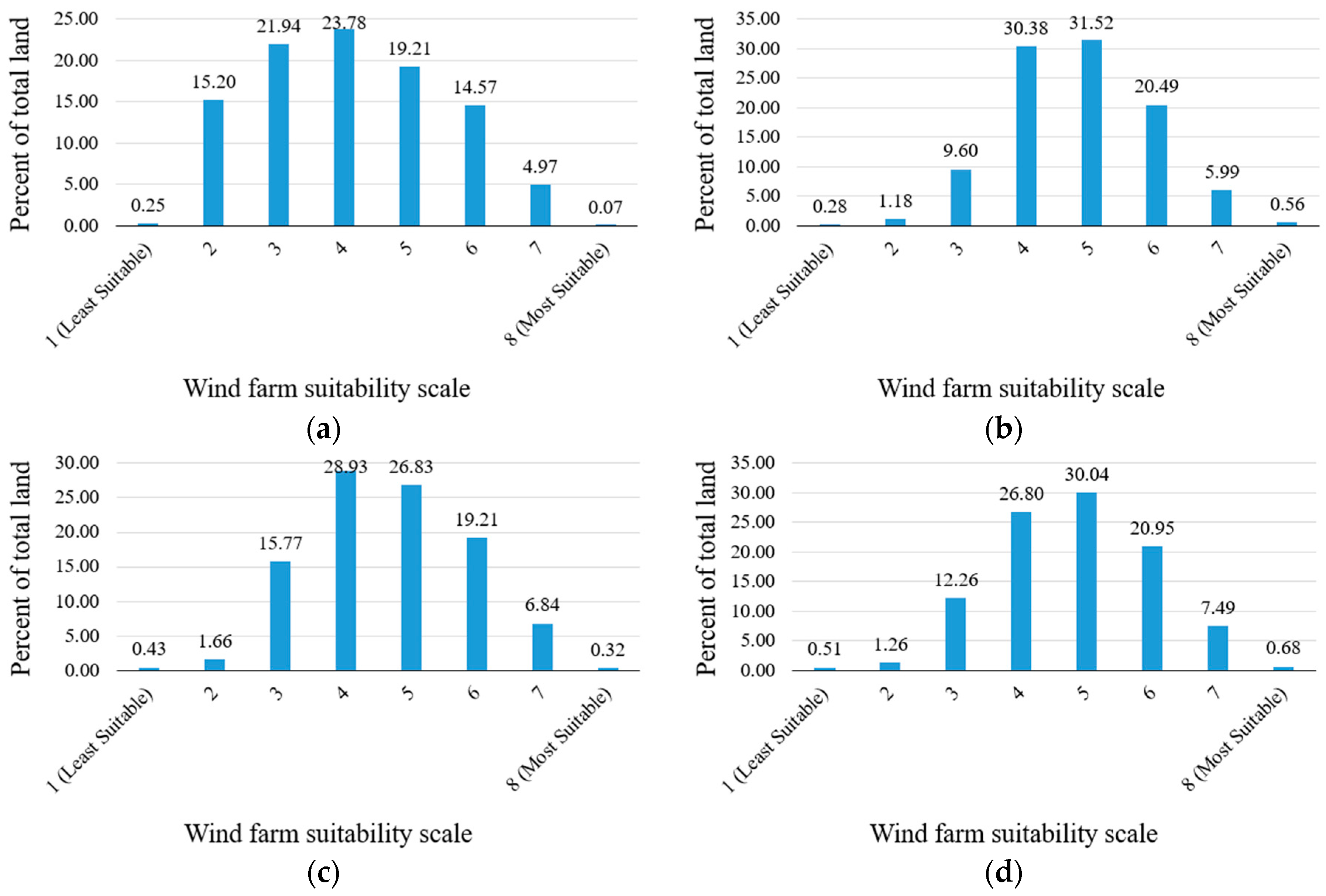
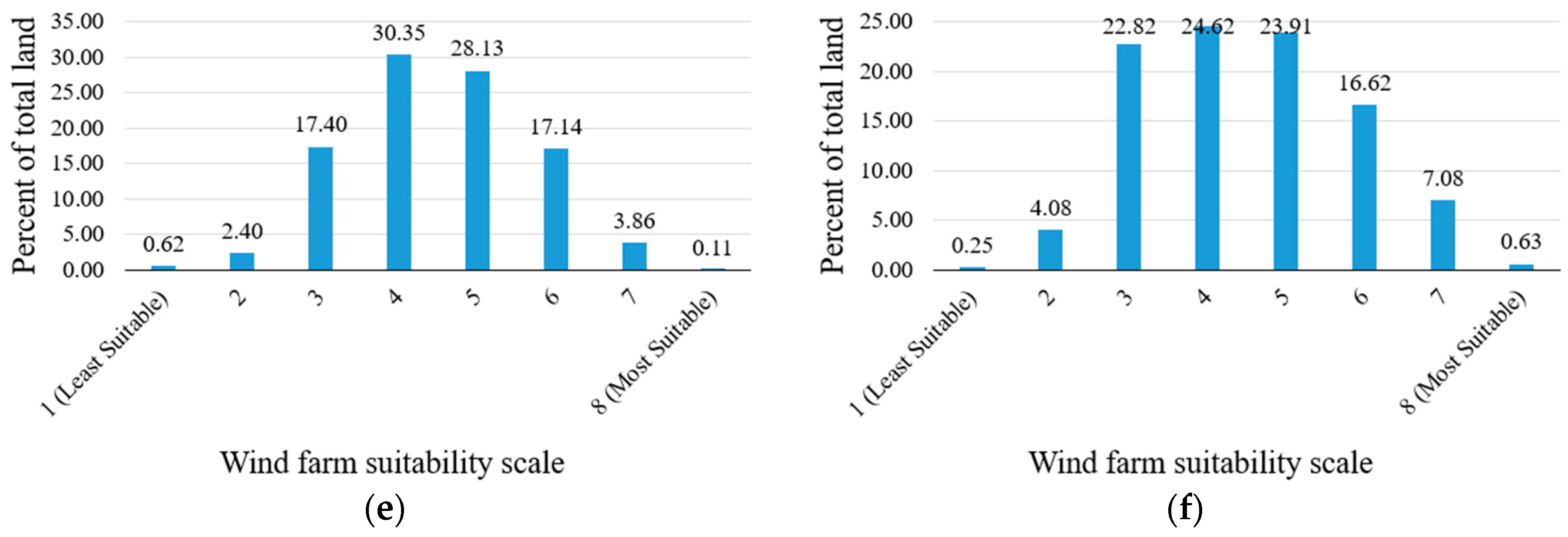
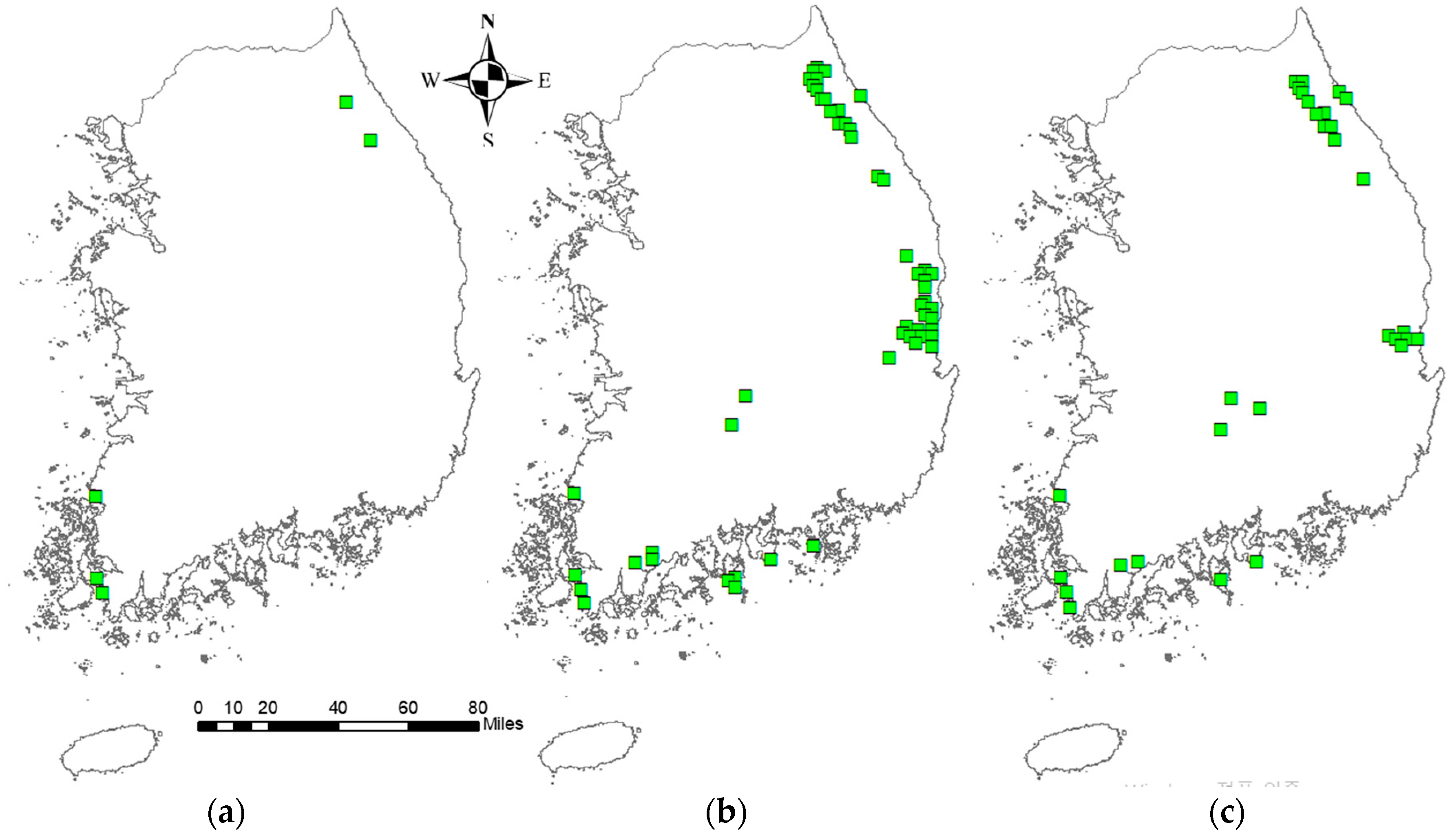
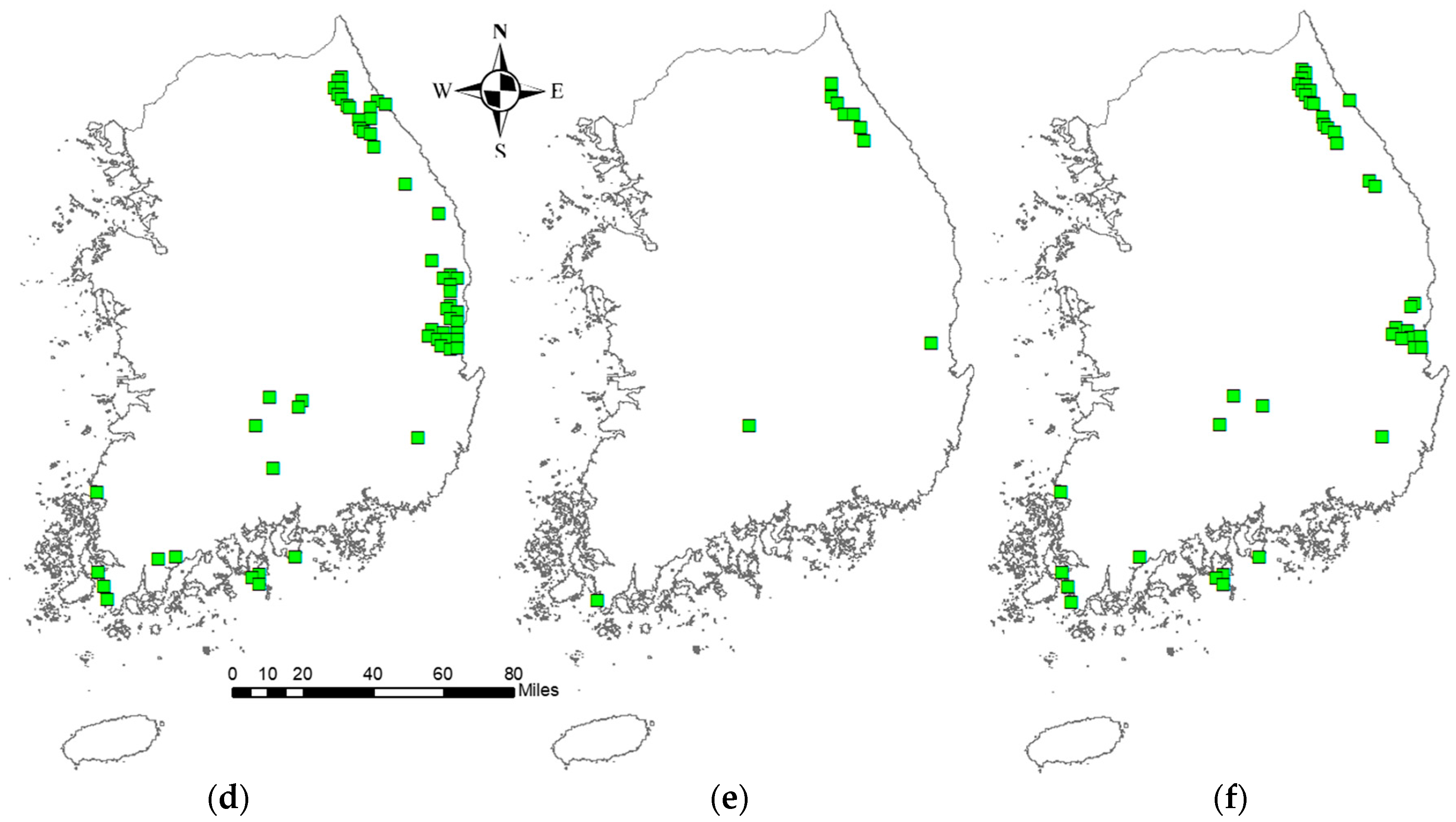
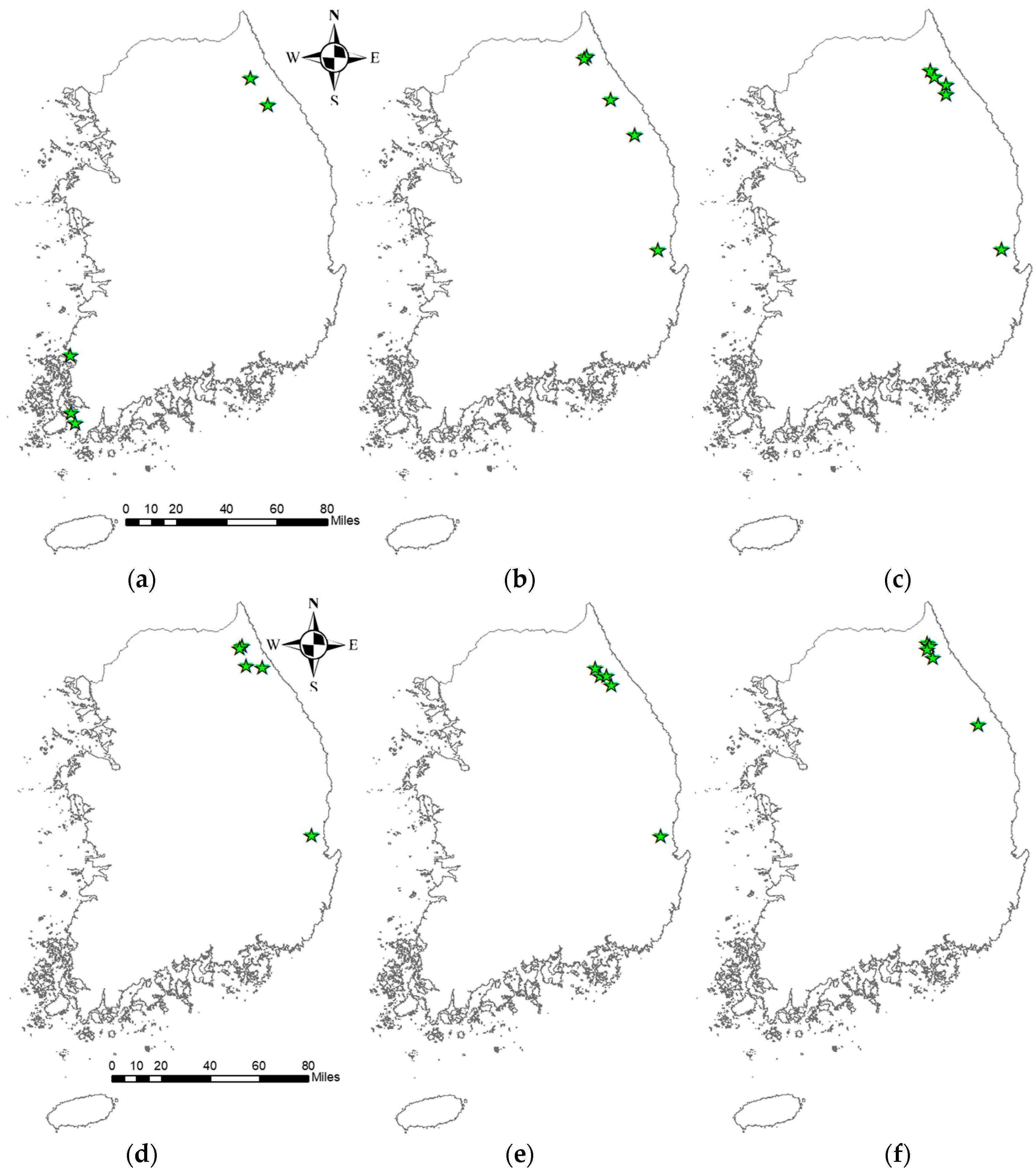
| AHP Scale | Linguistic Statement | FAHP Scale |
|---|---|---|
| 1 | Equally important | (1, 1, 1) |
| 3 | Weakly important | (2, 3, 4) |
| 5 | Fairly important | (4, 5, 6) |
| 7 | Strongly important | (6, 7, 8) |
| 9 | Absolutely important | (9, 9, 9 |
| 2 | Interpolation scale | (1, 2, 3) |
| 4 | (3, 4, 5) | |
| 6 | (5, 6, 7) | |
| 8 | (7, 8, 9) |
| Field of Research | References |
|---|---|
| Space heating [29] | Jaber et al. [29] |
| Renewables [30,31,32,33] | Kahraman et al. [30] |
| Heo et al. [31] | |
| Tasri and Susilawati [32] | |
| Ren and Sovacool [33] | |
| Bio Energy [34] | Chang et al. [34] |
| Hybrid [35] | Chen et al. [35] |
| Solar [36] | Lee et al. [36] |
| Wind [37,38,39,40] | Yeh and Huang [37] |
| Shafiee [38] | |
| Liu et al. [39] | |
| Lee et al. [40] |
| Criteria | C1 | C2 | C3 | C4 | C5 | C6 | C7 |
|---|---|---|---|---|---|---|---|
| C1 | (1, 1, 1) | (1, 1, 1) | (2, 3, 4) | (2, 3, 4) | (6, 7, 8) | (1/6, 1/5, 1/4) | (1/8, 1/7, 1/6) |
| C2 | (1, 1, 1) | (1, 1, 1) | (2, 3, 4) | (2, 3, 4) | (6, 7, 8) | (1/6, 1/5, 1/4) | (1/8, 1/7, 1/6) |
| C3 | (1/4, 1/3, 1/2) | (1/4, 1/3, 1/2) | (1, 1, 1) | (1, 2, 3) | (4, 5, 6) | (1/8, 1/7, 1/6) | (1/9, 1/8, 1/7) |
| C4 | (1/4, 1/3, 1/2) | (1/4, 1/3, 1/2) | (1/3, 1/2, 1) | (1, 1, 1) | (2, 3, 4) | (1/9, 1/8, 1/7) | (1/9, 1/8, 1/7) |
| C5 | (1/8, 1/7, 1/6) | (1/8, 1/7, 1/6) | (1/6, 1/5, 1/4) | (1/4, 1/3, 1/2) | (1, 1, 1) | (1/9, 1/9, 1/9) | (1/9, 1/9, 1/9) |
| C6 | (4, 5, 6) | (4, 5, 6) | (6, 7, 8) | (7, 8, 9) | (9, 9, 9) | (1, 1, 1) | (1/4, 1/3, 1/2) |
| C7 | (6, 7, 8) | (6, 7, 8) | (7, 8, 9) | (7, 8, 9) | (9, 9, 9) | (2, 3, 4) | (1, 1, 1) |
| Criteria | C1 | C2 | C3 | C4 | C5 | C6 | C7 |
|---|---|---|---|---|---|---|---|
| C1 | (1, 1, 1) | (1, 2, 3) | (1, 1, 1) | (1/4, 1/3, 1/2) | (4, 5, 6) | (1/4, 1/3, 1/2) | (1/4, 1/3, 1/2) |
| C2 | (1/3, 1/2, 1) | (1, 1, 1) | (1, 1, 1) | (1/5, 1/4, 1/3) | (2, 3, 4) | (1/5, 1/4, 1/3) | (1/5, 1/4, 1/3) |
| C3 | (1, 1, 1) | (1, 1, 1) | (1, 1, 1) | (1/5, 1/4, 1/3) | (2, 3, 4) | (1/5, 1/4, 1/3) | (1/5, 1/4, 1/3) |
| C4 | (2, 3, 4) | (3, 4, 5) | (3, 4, 5) | (1, 1, 1) | (3, 4, 5) | (1/4, 1/3, 1/2) | (1/4, 1/3, 1/2) |
| C5 | (1/6, 1/5, 1/4) | (1/4, 1/3, 1/2) | (1/4, 1/3, 1/2) | (1/5, 1/4, 1/3) | (1, 1, 1) | (1/8, 1/7, 1/6) | (1/8, 1/7, 1/6) |
| C6 | (2, 3, 4) | (3, 4, 5) | (3, 4, 5) | (2, 3, 4) | (6, 7, 8) | (1, 1, 1) | (1/3, 1/2, 1) |
| C7 | (2, 3, 4) | (3, 4, 5) | (3, 4, 5) | (2, 3, 4) | (6, 7, 8) | (1, 2, 3) | (1, 1, 1) |
| Criteria | C1 | C2 | C3 | C4 | C5 | C6 | C7 |
|---|---|---|---|---|---|---|---|
| C1 | (1, 1, 1) | (2, 3, 4) | (2, 3, 4) | (1, 1, 1) | (5, 6, 7) | (1/4, 1/3, 1/2) | (1/7, 1/6, 1/5) |
| C2 | (1/4, 1/3, 1/2) | (1, 1, 1) | (1, 2, 3) | (1/3, 1/2, 1) | (3, 4, 5) | (1/5, 1/4, 1/3) | (1/8, 1/7, 1/6) |
| C3 | (1/4, 1/3, 1/2) | (1/3, 1/2, 1) | (1, 1, 1) | (1/4, 1/3, 1/2) | (2, 3, 4) | (1/8, 1/7, 1/6) | (1/9, 1/8, 1/7) |
| C4 | (1, 1, 1) | (1, 2, 3) | (2, 3, 4) | (1, 1, 1) | (4, 5, 6) | (1/4, 1/3, 1/2) | (1/5, 1/4, 1/3) |
| C5 | (1/7, 1/6, 1/5) | (1/5, 1/4, 1/3) | (1/4, 1/3, 1/2) | (1/6, 1/5, 1/4) | (1, 1, 1) | (1/8, 1/7, 1/6) | (1/9, 1/8, 1/7) |
| C6 | (2, 3, 4) | (3, 4, 5) | (6, 7, 8) | (2, 3, 4) | (6, 7, 8) | (1, 1, 1) | (1/3, 1/2, 1) |
| C7 | (5, 6, 7) | (6, 7, 8) | (7, 8, 9) | (3, 4, 5) | (7, 8, 9) | (1, 2, 3) | (1, 1, 1) |
| Criteria | C1 | C2 | C3 | C4 | C5 | C6 | C7 |
|---|---|---|---|---|---|---|---|
| C1 | (1, 1, 1) | (2, 3, 4) | (1, 2, 3) | (1, 2, 3) | (5, 6, 7) | (1/4, 1/3, 1/2) | (1/7, 1/6, 1/5) |
| C2 | (1/4, 1/3, 1/2) | (1, 1, 1) | (1/3, 1/2, 1) | (1/3, 1/2, 1) | (4, 5, 6) | (1/5, 1/4, 1/3) | (1/8, 1/7, 1/6) |
| C3 | (1/3, 1/2, 1) | (1, 2, 3) | (1, 1, 1) | (1, 2, 3) | (5, 6, 7) | (1/3, 1/2, 1) | (1/7, 1/6, 1/5) |
| C4 | (1/3, 1/2, 1) | (1, 2, 3) | (1/3, 1/2, 1) | (1, 1, 1) | (4, 5, 6) | (1/4, 1/3, 1/2) | (1/8, 1/7, 1/6) |
| C5 | (1/7, 1/6, 1/5) | (1/6, 1/5, 1/4) | (1/7, 1/6, 1/5) | (1/6, 1/5, 1/4) | (1, 1, 1) | (1/8, 1/7, 1/6) | (1/9, 1/8, 1/7) |
| C6 | (2, 3, 4) | (3, 4, 5) | (1, 2, 3) | (2, 3, 4) | (6, 7, 8) | (1, 1, 1) | (1/4, 1/3, 1/2) |
| C7 | (5, 6, 7) | (6, 7, 8) | (5, 6, 7) | (6, 7, 8) | (7, 8, 9) | (2, 3, 4) | (1, 1, 1) |
| Criteria | C1 | C2 | C3 | C4 | C5 | C6 | C7 |
|---|---|---|---|---|---|---|---|
| C1 | (1, 1, 1) | (1/3, 1/2, 1) | (1, 1, 1) | (1/5, 1/4, 1/3) | (4, 5, 6) | (1/4, 1/3, 1/2) | (1/7, 1/6, 1/5) |
| C2 | (1, 2, 3) | (1, 1, 1) | (1, 2, 3) | (1/4, 1/3, 1/2) | (5, 6, 7) | (1/3, 1/2, 1) | (1/6, 1/5, 1/4) |
| C3 | (1, 1, 1) | (1/3, 1/2, 1) | (1, 1, 1) | (1/5, 1/4, 1/3) | (4, 5, 6) | (1/4, 1/3, 1/2) | (1/7, 1/6, 1/5) |
| C4 | (3, 4, 5) | (2, 3, 4) | (3, 4, 5) | (1, 1, 1) | (5, 6, 7) | (1/3, 1/2, 1) | (1/4, 1/3, 1/2) |
| C5 | (1/6, 1/5, 1/4) | (1/7, 1/6, 1/5) | (1/6, 1/5, 1/4) | (1/7, 1/6, 1/5) | (1, 1, 1) | (1/7, 1/6, 1/5) | (1/9, 1/8, 1/7) |
| C6 | (2, 3, 4) | (1, 2, 3) | (2, 3, 4) | (1, 2, 3) | (5, 6, 7) | (1, 1, 1) | (1/4, 1/3, 1/2) |
| C7 | (5, 6, 7) | (4, 5, 6) | (5, 6, 7) | (2, 3, 4) | (7, 8, 9) | (2, 3, 4) | (1, 1, 1) |
| Criteria | Geometric Mean | ||
|---|---|---|---|
| C1 | 0.91 | 1.09 | 1.27 |
| C2 | 0.91 | 1.09 | 1.27 |
| C3 | 0.45 | 0.57 | 0.73 |
| C4 | 0.34 | 0.43 | 0.57 |
| C5 | 0.19 | 0.21 | 0.24 |
| C6 | 2.85 | 3.29 | 3.81 |
| C7 | 4.40 | 5.06 | 5.66 |
| Sum | 10.03 | 11.73 | 13.55 |
| Inverse (1/Sum) | 0.10 | 0.09 | 0.07 |
| Increasing Order | 0.07 | 0.09 | 0.10 |
| Criteria | l | m | u |
|---|---|---|---|
| C1 | 0.067 | 0.093 | 0.127 |
| C2 | 0.067 | 0.093 | 0.127 |
| C3 | 0.033 | 0.049 | 0.072 |
| C4 | 0.025 | 0.036 | 0.057 |
| C5 | 0.014 | 0.018 | 0.024 |
| C6 | 0.210 | 0.281 | 0.380 |
| C7 | 0.324 | 0.431 | 0.565 |
| Criteria | A | w |
|---|---|---|
| C1 | 0.095 | 0.093 |
| C2 | 0.095 | 0.093 |
| C3 | 0.051 | 0.050 |
| C4 | 0.040 | 0.038 |
| C5 | 0.018 | 0.018 |
| C6 | 0.290 | 0.282 |
| C7 | 0.440 | 0.427 |
| Criteria | Scenario 1 | Scenario 2 | Scenario 3 | Scenario 4 | Scenario 5 | Scenario 6 |
|---|---|---|---|---|---|---|
| C1 | 14.28 | 9.26 | 9.42 | 11.16 | 11.75 | 6.40 |
| C2 | 14.28 | 9.26 | 6.42 | 6.46 | 5.62 | 10.12 |
| C3 | 14.28 | 4.98 | 6.83 | 4.36 | 10.13 | 6.40 |
| C4 | 14.28 | 3.84 | 16.73 | 10.94 | 7.54 | 18.03 |
| C5 | 14.28 | 1.79 | 2.97 | 2.35 | 2.03 | 2.18 |
| C6 | 14.28 | 28.17 | 26.38 | 25.66 | 19.98 | 18.66 |
| C7 | 14.28 | 42.71 | 31.25 | 39.06 | 42.95 | 38.20 |
| Scenario | Accumulated Area (km2) | Total Number of Sites |
|---|---|---|
| Scenario 1 | 70 | 5 |
| Scenario 2 | 560 | 53 |
| Scenario 3 | 320 | 30 |
| Scenario 4 | 680 | 56 |
| Scenario 5 | 110 | 10 |
| Scenario 6 | 630 | 41 |
| Site Ranking | Overall Total Site Score (%) | Latitude (°) | Longitude (°) | Area (km2) | Distance to Nearest Power Stations (km) | Distance to Nearest Power Lines (km) | Distance to Nearest Roads (km) | Distance to Nearest Cities (km) | Distance to Nearest Railway Lines (km) | Mean Slope (%) | Mean Wind Speed (m/s) |
|---|---|---|---|---|---|---|---|---|---|---|---|
| 1 | 76.66 | 34.58 | 126.42 | 29.48 | 15.00 | 13.13 | 0.07 | 23.66 | 21.47 | 3.41 | 6.61 |
| 2 | 73.19 | 34.48 | 126.46 | 14.74 | 14.11 | 9.12 | 2.20 | 34.98 | 21.43 | 1.27 | 6.75 |
| 3 | 68.96 | 37.68 | 128.67 | 7.37 | 19.67 | 10.05 | 0.41 | 20.25 | 18.44 | 8.98 | 8.27 |
| 4 | 63.67 | 37.95 | 128.45 | 7.37 | 11.79 | 9.45 | 0.72 | 31.53 | 44.38 | 3.73 | 8.21 |
| 5 | 59.38 | 35.15 | 126.38 | 7.37 | 16.75 | 16.80 | 1.28 | 33.64 | 20.27 | 2.28 | 6.48 |
| Site Ranking | Overall Total Site Score (%) | Latitude (°) | Longitude (°) | Area (km2) | Distance to Nearest Power Stations (km) | Distance to Nearest Power Lines (km) | Distance to Nearest Roads (km) | Distance to Nearest Cities (km) | Distance to Nearest Railway Lines (km) | Mean Slope (%) | Mean Wind Speed (m/s) |
|---|---|---|---|---|---|---|---|---|---|---|---|
| 1 | 73.03 | 34.39 | 126.49 | 14.74 | 9.11 | 8.89 | 1.50 | 46.15 | 10.23 | 1.41 | 7.06 |
| 2 | 69.76 | 34.48 | 126.46 | 14.74 | 14.11 | 9.12 | 2.20 | 34.98 | 21.43 | 1.27 | 6.61 |
| 3 | 68.82 | 38.14 | 128.45 | 7.37 | 10.95 | 7.96 | 0.12 | 14.54 | 52.98 | 3.83 | 9.39 |
| 4 | 67.73 | 34.81 | 128.38 | 7.37 | 17.72 | 12.38 | 0.00 | 2.13 | 41.11 | 1.79 | 6.63 |
| 5 | 66.78 | 34.59 | 127.73 | 7.37 | 32.85 | 25.79 | 1.62 | 19.65 | 18.42 | 1.14 | 7.14 |
| Site Ranking | Overall Total Site Score (%) | Latitude (°) | Longitude (°) | Area (km2) | Distance to Nearest Power Stations (km) | Distance to Nearest Power Lines (km) | Distance to Nearest Roads (km) | Distance to Nearest Cities (km) | Distance to Nearest Railway Lines (km) | Mean Slope (%) | Mean Wind Speed (m/s) |
|---|---|---|---|---|---|---|---|---|---|---|---|
| 1 | 71.38 | 35.64 | 127.72 | 7.37 | 13.24 | 11.73 | 0.34 | 36.34 | 12.43 | 0.55 | 6.76 |
| 2 | 60.28 | 34.59 | 127.73 | 7.37 | 32.85 | 25.79 | 1.62 | 19.65 | 18.42 | 1.14 | 7.14 |
| 3 | 59.55 | 38.02 | 128.70 | 7.37 | 12.59 | 5.17 | 0.29 | 22.64 | 33.52 | 3.39 | 7.30 |
| 4 | 58.03 | 37.97 | 128.76 | 7.37 | 18.67 | 9.89 | 0.06 | 26.43 | 26.08 | 1.90 | 7.16 |
| 5 | 56.35 | 37.41 | 128.91 | 7.37 | 19.81 | 12.21 | 1.27 | 21.96 | 12.71 | 5.32 | 8.27 |
| Site Ranking | Overall Total Site Score (%) | Latitude (°) | Longitude (°) | Area (km2) | Distance to Nearest Power Stations (km) | Distance to Nearest Power Lines (km) | Distance to Nearest Roads (km) | Distance to Nearest Cities (km) | Distance to Nearest Railway Lines (km) | Mean Slope (%) | Mean Wind Speed (m/s) |
|---|---|---|---|---|---|---|---|---|---|---|---|
| 1 | 66.44 | 34.69 | 126.90 | 14.74 | 18.69 | 12.93 | 0.13 | 38.14 | 18.26 | 0.73 | 6.55 |
| 2 | 62.00 | 37.95 | 128.63 | 7.37 | 10.45 | 0.49 | 0.30 | 29.11 | 30.86 | 9.70 | 8.42 |
| 3 | 61.65 | 37.19 | 129.22 | 7.37 | 18.10 | 6.40 | 3.96 | 20.86 | 15.88 | 1.55 | 7.61 |
| 4 | 61.15 | 34.39 | 126.49 | 14.74 | 9.11 | 8.89 | 1.50 | 46.15 | 10.23 | 1.41 | 7.06 |
| 5 | 61.07 | 37.67 | 128.67 | 14.74 | 20.22 | 9.79 | 0.16 | 20.84 | 17.13 | 1.82 | 7.96 |
| Site Ranking | Overall Total Site Score (%) | Latitude (°) | Longitude (°) | Area (km2) | Distance to Nearest Power Stations (km) | Distance to Nearest Power Lines (km) | Distance to Nearest Roads (km) | Distance to Nearest Cities (km) | Distance to Nearest Railway Lines (km) | Mean Slope (%) | Mean Wind Speed (m/s) |
|---|---|---|---|---|---|---|---|---|---|---|---|
| 1 | 72.46 | 35.64 | 127.72 | 7.37 | 13.24 | 11.73 | 0.34 | 36.34 | 12.43 | 0.55 | 6.76 |
| 2 | 64.17 | 37.99 | 128.39 | 7.37 | 14.54 | 12.53 | 0.03 | 29.61 | 51.76 | 4.54 | 6.98 |
| 3 | 62.34 | 37.87 | 128.57 | 7.37 | 15.82 | 9.03 | 0.26 | 29.85 | 31.07 | 17.49 | 8.55 |
| 4 | 60.95 | 34.37 | 126.50 | 7.37 | 8.88 | 8.76 | 1.50 | 47.48 | 8.94 | 4.05 | 7.06 |
| 5 | 60.15 | 36.23 | 129.23 | 14.74 | 29.60 | 11.63 | 0.05 | 25.89 | 19.34 | 32.56 | 8.01 |
| Site Ranking | Overall Total Site Score (%) | Latitude (°) | Longitude (°) | Area (km2) | Distance to Nearest Power Stations (km) | Distance to Nearest Power Lines (km) | Distance to Nearest Roads (km) | Distance to Nearest Cities (km) | Distance to Nearest Railway Lines (km) | Mean Slope (%) | Mean Wind Speed (m/s) |
|---|---|---|---|---|---|---|---|---|---|---|---|
| 1 | 69.99 | 34.59 | 127.73 | 7.37 | 32.85 | 25.79 | 1.62 | 19.65 | 18.42 | 1.14 | 6.95 |
| 2 | 67.99 | 37.36 | 128.97 | 7.37 | 19.00 | 11.33 | 1.07 | 19.62 | 5.06 | 22.53 | 9.01 |
| 3 | 67.93 | 38.17 | 128.39 | 7.37 | 15.45 | 11.70 | 0.56 | 18.62 | 49.76 | 26.57 | 9.15 |
| 4 | 67.88 | 37.97 | 128.76 | 7.37 | 18.67 | 9.89 | 0.06 | 26.43 | 26.08 | 1.90 | 7.16 |
| 5 | 67.58 | 34.48 | 126.46 | 14.74 | 14.11 | 9.12 | 2.20 | 34.98 | 21.43 | 1.27 | 6.61 |
© 2017 by the authors. Licensee MDPI, Basel, Switzerland. This article is an open access article distributed under the terms and conditions of the Creative Commons Attribution (CC BY) license (http://creativecommons.org/licenses/by/4.0/).
Share and Cite
Ali, S.; Lee, S.-M.; Jang, C.-M. Determination of the Most Optimal On-Shore Wind Farm Site Location Using a GIS-MCDM Methodology: Evaluating the Case of South Korea. Energies 2017, 10, 2072. https://doi.org/10.3390/en10122072
Ali S, Lee S-M, Jang C-M. Determination of the Most Optimal On-Shore Wind Farm Site Location Using a GIS-MCDM Methodology: Evaluating the Case of South Korea. Energies. 2017; 10(12):2072. https://doi.org/10.3390/en10122072
Chicago/Turabian StyleAli, Sajid, Sang-Moon Lee, and Choon-Man Jang. 2017. "Determination of the Most Optimal On-Shore Wind Farm Site Location Using a GIS-MCDM Methodology: Evaluating the Case of South Korea" Energies 10, no. 12: 2072. https://doi.org/10.3390/en10122072




